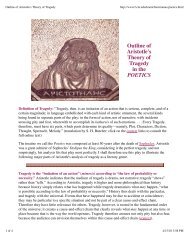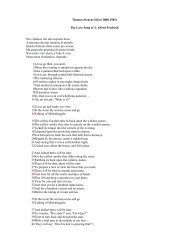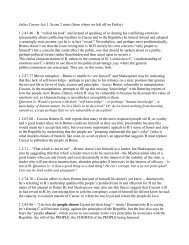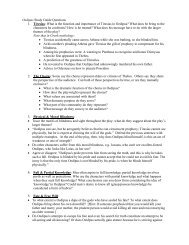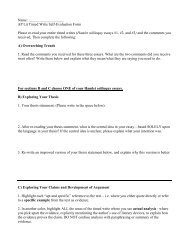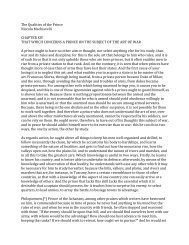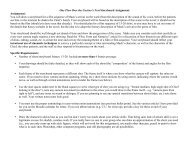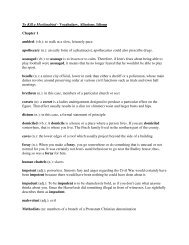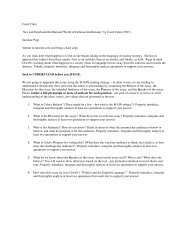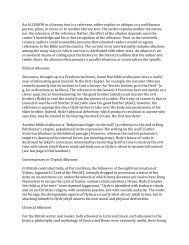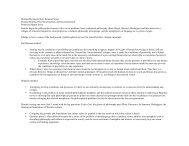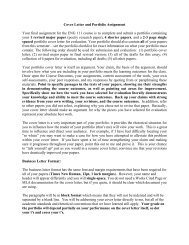<strong>AP</strong> <strong>English</strong> – C&P <strong>Style</strong> <strong>Analysis</strong> <strong>Part</strong> I <strong>Samples</strong>Sample #2:As the passage progresses, Dostoevsky uses the resources of language to convey that Raskolnikov ismoving further and further into his on mind, and further from traditional society. Aspects of language that lendthemselves to Dostoevsky’s purpose are his ability to weave past and present ideas together, utilize metaphors,choose words that demonstrate Raskolnikov mentally isolating himself, and the use of sentences that wander andflounder much like Raskolnikov. Raskolnikov’s state of mind at the beginning is nostalgic, but Dostoevsky usesthe resources of language to portray a change from that to a state of mind that is alienated from his old thoughts,more conventional thoughts.Dostoevsky weaves together the past and present in Raskolnikov’s mind in order to emphasize thechange that Raskolnikov is going through. It is clear that Raskolnokov used to enjoy the view on his way homeand even knew that it was “at its best from the bridge about twenty paces away from the chapel.” He not onlynoticed the view, but made a point to find the place that looked the best. He calls it a “truly magnificentspectacle” but it still left him feeling “strangely cold.” In this way, Dostoevsky uses the comparison of past andpresent to highlight Raskolnikov’s removed state of mind.Diction used when Raskolnikov is describing what he is thinking about illustrates how he is distancinghimself from his past self. At first Raskolnikov contemplates how many times when he was at the university hestood at the same spot and remembers the “vague and mysterious emotions it aroused in him,” but nowrecognizing that it left him feeling “blank and lifeless.” This comparison makes it seem nostalgic, because hecannot go back to his previous state of mind when he was mostly content to marvel and enjoy. Later in thepassage he describes the idea of trying to return to his past habits of mind as well as movement as “strange andgrotesque.” This is a recognition of how far Raskolnikov has moved from where he once was. Then Dostoevskyuses the repetition of the word “old” to portray the way that Raskolnikov is trying even more to distance himselffrom his past, and emphasize the isolated nature of his mind.The ability of language to go beyond the literal is a resource that Dostoevsky utilizes to illustrate thenature of Raskolnikov’s rejection of society. This happens when it says, “He felt as though he were flyingupwards and everything were vanishing from sight.” This is a way of saying that, mentally, Raskolnikov isleaving behind all of his “old thoughts,” like they were “vanishing.” The fact that he is flying upwards alsoimplies that it will be hard to return to where he was right before, if it is even possible. The coin is used tosymbolize society in this passage. All the time Rasolnikov is dwelling on his past life he is “unconscious” of thecoin he is holding in his hand. At the end, however, Raskolnikov “flung it into the water” to represent hisrejection of society and how its ideals were a part if his life. That is why the throwing of the coin made him feelthat “he had cut himself off from everyone and everything at that moment.” The feeling of flying and the coinmean more in the passage than their literal meaning, and through this use of metaphors Dostoevsky is using aresource of language to convey Raskolnikov’s progressively more isolated state of mind. (Ran out of time to talkabout syntax and write a conclusion)
<strong>AP</strong> <strong>English</strong> – C&P <strong>Style</strong> <strong>Analysis</strong> <strong>Part</strong> I <strong>Samples</strong>Sample #3:In this passage from Fyodor Dostoevsky’s Crime and Punishment, Dostoevsky uses diction to highlightdifferences between Raskolnikov’s beautiful surroundings and his empty state of mind. Also, through the syntaxof the passage, Dostoevsky shows how Raskolnikov is disconnected from his past life (his past actions,thoughts), which contributes to Raskolnikov’s emptiness. Through conveying Raskolnikov as empty,Dostoevsky reveals the personality change that Raskolnikov experienced after the murders of Alyona andLizaveta and Raskolnikov’s realization of this change as well.At the beginning of the passage, Dostoevsky describes the scenery if the palace and cathedral as“glitter[ing] in the sunset,” “truly magnificent,” and “without a cloud and the water was almost bright blue,”which is then contrasted with Raskolnikov’s empty mindset and emotions. The first part of the passage describesthe beauty of the palace and cathedral, especially from one particular spot that Raskolnikov had stood on manytimes before. Dostoevsky’s word choice, such as “bright,” glittered,” “pure air” and “magnificent spectacle”exposes the palace and cathedral as extremely picturesque and as a sight that should invoke strong, aweful [awefilled?]emotions in a person. However, in the second half of the passage, the emptiness that Raskolnikov feelsis revealed. Raskolnikov [the narrator?] explains how the view of the palace and cathedral “left him strangelycold” and how the “gorgeous picture was for him blank and lifeless.” Dostoevsky’s diction here shows thedisconnectedness of Raskolnikov from his surroundings and the emptiness he feels, which can be seen throughthe phrases “strangely cold” and “blank and lifeless.” Raskolnikov appears to not know why he feels so emptyby saying he “put off finding the explanation of it,” but later he thinks it weird how “he actually imagined hecould think the same thoughts, be interested in the same theories and pictures that had interested him…so short atime ago.” This later thought shows how Rasklnikov realizes the emptiness he feels is because of the murders hecommitted, because after this act he feel empty because he cannot be interested in the same things he wasinterested in before he killed Alonya and Lizaveta. Dostoevsky employs many dark words after his descriptionof the scenery, which is in contrast to Raskolnikov’s feeling of emptiness. Raskolnikov’s “blank and lifeless”and isolated feelings are contrasted to the “bright” and “magnificent” scenery, a device that Dostoevsky uses toexemplify Raskolnikov’s true state of mind.Dostoevsky’s use of ellipses furthers the reader’s impression of Raskolnikov’s emptiness because itconveys him as unsure and disconnected from his surroundings. The line “he actually imagined he could thinkthe same thoughts, be interested in the same theories and pictures that had interested him…so short a time ago”shows how Raskolnikov can no longer identify with his past thoughts and actions. The ellipses at the end of theline convey the idea that Raskolnikov is trailing off in his thought process, which means he is unsure of himselfnow. Dostoevsky also uses ellipses later, in the line “Deep down, hidden far away out of sight all that seemed tohim now – all his old past, his old thoughts, his old problems and theories, his old impressions and that pictureand himself and all, all…He felt as though he were flying upwards, and everything were vanishing from hissight.” The ellipses here is another example of Raskolikov’s feeling of emptiness, through his disconnect fromhis past. “Everything were vanishing from his sight” also shows how Raskolnikov has lost the ability to connectto his past or his surroundings, which also contributes to his emptiness. The ellipses shows this disconnect aswell because it show how Raskolnikov’s thoughts trail off before they are finished.Through Raskolnikov’s state of mind and disconnect, Dostoevsky shows Raskolnikov’s personalitychange to emptiness, and his realization of this change. Raskolnikov’s realization of his emptiness can be seenwhen he remarks, “It seemed to him, he had cut himself off from everyone and from everything.” Raskolnikovis able to realize that the murders he committed did change him in a negative way, so much so that he appears tono longer be able to really feel anything.Dostoevsky’s diction throughout the passage contrasts Raskolnikov’s surroundings with his state ofmind, and helps convey Raskolnikov’s feelings of disconnect and emptiness. The syntax that Dostoevskyemploys, especially his use of ellipses, shows how Raskolnikov is unsure of himself and cannot even finishthoughts. Through Raskolnikov’s stat of mind, Dostoevsky shows Raskolnikov’s realization of the changes themurders brought upon him.




